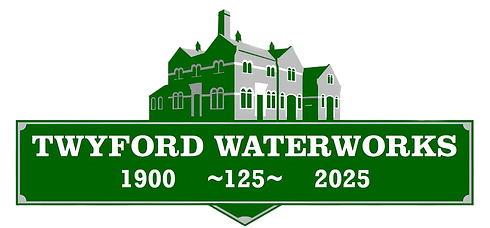
History
Twyford Waterworks is an Edwardian pumping station containing a unique selection of buildings and machinery within a rural downland setting in the heart of Hampshire. The site was given the status of a Scheduled Ancient Monument in 1973 and passed, as such, to the Southern Water Authority on 1st April 1974. In 1985 the Twyford Waterworks Trust was incorporated as a charity to run it. The Trust obtained a lease for the redundant parts of the site in 1992. With the privatisation of the water supply industry, the works passed to Southern Water Services who are the present owners of the site and who still extract 5 million gallons (25 megalitres) from the original boreholes.
Although built and extended over 30 years, the main buildings present a coherent set of high quality public works buildings of the early twentieth century when authorities had a pride in their public façade. The older sections have escaped demolition and thus a complete series of steam, diesel, separate d.c. motors and modern submersible electric pumps is still available for the public to view and, in many cases, see in operation.


Many steam engines have survived without their associated boiler houses: at Twyford is one of the most complete boiler houses left in terms of its equipment, and unique in having a rank of three Babcock & Wilcox WIF water tube boilers of which the Trust has restored one back to steam. This gives a vignette into the ‘high tech’ boiler houses of the Edwardian era and provides the steam source for the 1914 Hathorn Davey triple expansion engine in the adjoining engine house. This is the last set of three classic B & W WIF boilers to survive. (A singleton of 1926 survives at Cheddars Lane, Cambridge.) The B & W WIF boiler dominated the boiler market for steam pumping engines and electricity generation in the period 1890-1914, yet almost none survive. The boiler house itself is the hub of a very complete steam plant since it contains two sets of steam boiler feed pumps, a steam air compressor and a steam driven d.c. generator with a diesel driven back-up generator. Coal was brought in on a 2 ft gauge railway and the track and weighbridge for the coal is still in place.
The site is unique in having both water extraction and a complete water softening treatment plant. Only coal needed to be brought in to Twyford. Chalk for the lime kilns was quarried on site and the Clark process softening plant stands complete and with sections workable. The five bottle kilns and their servicing system and railway; the water hydraulic engines working the railway incline and the lime mixing plant; the carbon dispenser; the Haines filters; even the mixing bell housing where the well water meets the ‘lime water’ in the softening tank are all in situ.

The site therefore caters for a variety of interests with the history of water supply, industrial artefacts for the enthusiast, the nature trail for the conservationist and adequate picnic areas. These are expanded on Open Days with themed exhibits from external exhibitors, and the site is a popular venue for a wide range of group visits by both local and national organisations.


